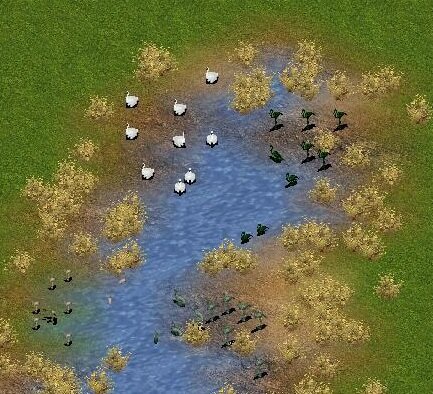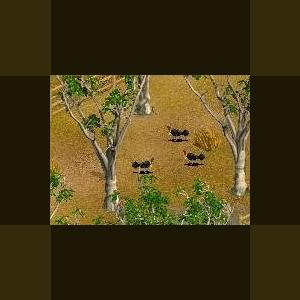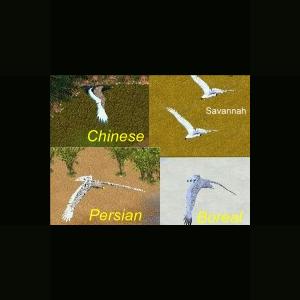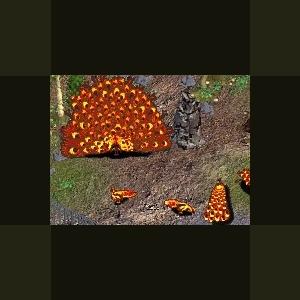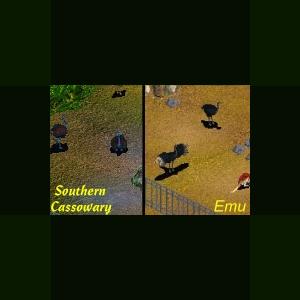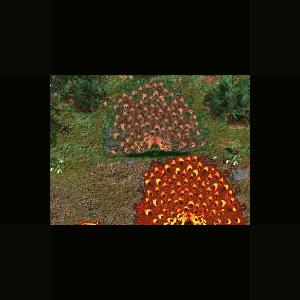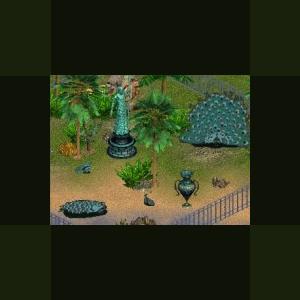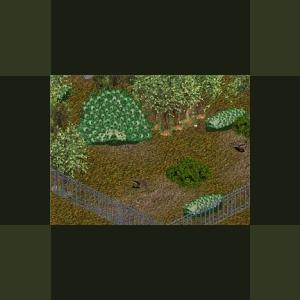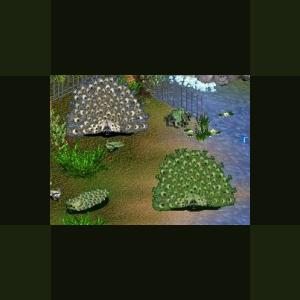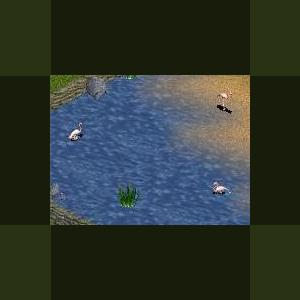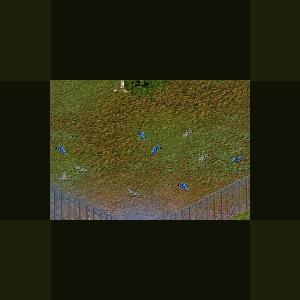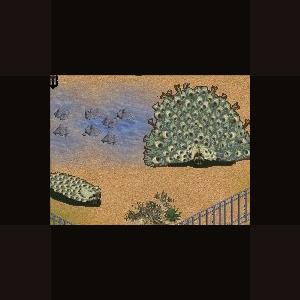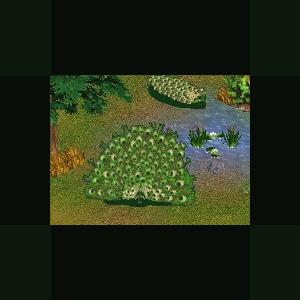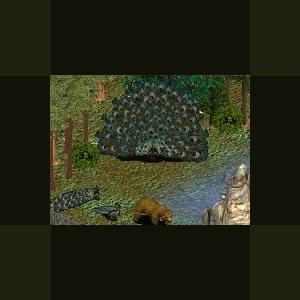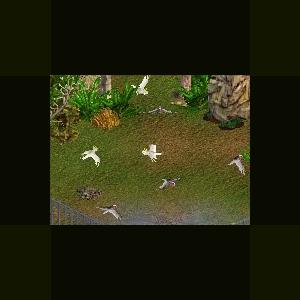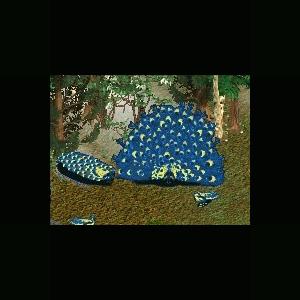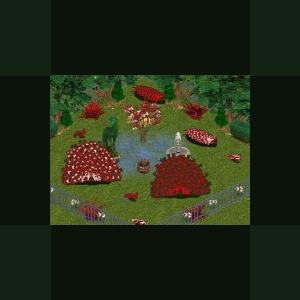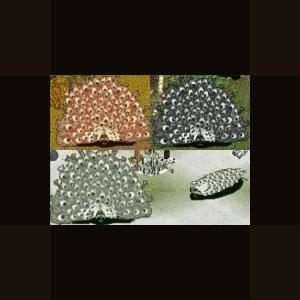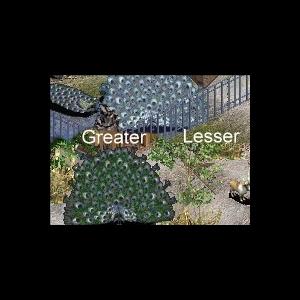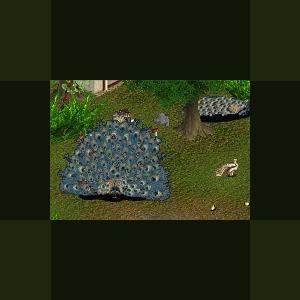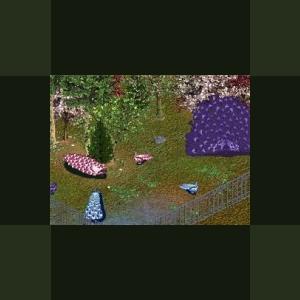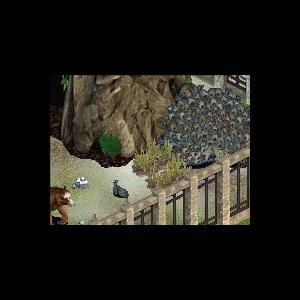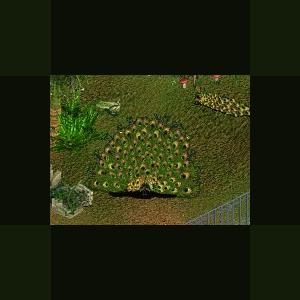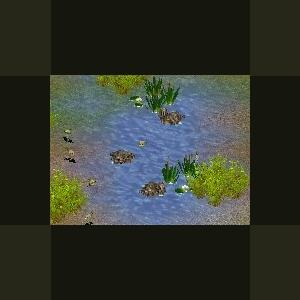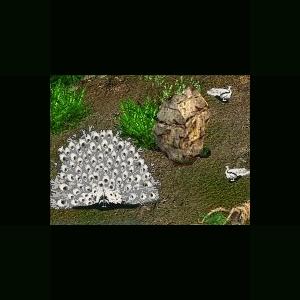Birds
Creatures on the wing
65 files
-
Great Blue Heron~Black Stork~Long-billed Crulew~Trumpeter Swan by Genkicoll
By Savannahjan
Also includes scrub brush foliage, preferred by the Long-billed Curlew.
The largest and most widespread heron in North America, the Great Blue Heron can be found along the ocean shore or the edge of a small inland pond. Although the Great Blue Heron eats primarily fish, it is adaptable and willing to eat other animals as well. It nests in colonies, sometimes as a lone pair.
Source: http://www.allaboutbirds.org/guide/Great_Blue_Heron/lifehistory
The Black Stork has shining black with iridiscent reflections. The rest of the plumage is pure white with red beak and feet. It can be found hroughout Europe, north to Scandinavia and west to Russia, and is primarily a forest species hunting in streams, small rivers and marshy ponds. The diet consists almost completely of small fish; also small mammals, reptiles, shellfish and insects.
The Long-billed Curlew (Numenius americanus) is the largest shorebird in North America. It breeds in shortgrass or mixedgrass to very dry grasslands. Long-billed Curlews are a late-maturing, long-lived species with low reproductive output. Eggs are olive-buff and are evenly spotted with brown or gray.
Source: http://www.abheritage.ca/abnature/speciesatrisk/curlew_intro.htm
The Trumpeter Swan, Cygnus buccinator, is the largest native North American bird, and the largest living waterfowl species on earth. These birds have white plumage with a long neck, a black bill subtly marked with salmon-pink along the mouthline, and short black legs. They feed while swimming. The diet is almost entirely aquatic plants. The Trumpeter Swan is listed as threatened in the state of Minnesota.
Inspired by the Zoo Tycoon Brains Trust at Zoo Tek Phoenix.
Updated 2010-11-21 to save space with less in zip.
59 downloads
0 comments
Submitted
-
Australian Brush-Turkey by And 1
By Guest
new Bird for your Game. Made by And 1
The Australian Brush-turkey Alectura lathami, also frequently called the Scrub Turkey or Bush Turkey, is a common, widespread species of mound-building bird from the family Megapodiidae found in eastern Australia from Far North Queensland to Illawarra in New South Wales. It has also been introduced to Kangaroo Island in South Australia. It is the largest extant representative of the family Megapodiidae and is one of three species to inhabit Australia. Despite its name, the bird is not closely related to American turkeys. It is a spectacular large bird with a prominent, fan-like tail flattened sideways. The Brush-turkey is mainly black but has a bare red head, and a yellow or bluish-grey wattle. Their undersides are sprinkled with white feathers, more pronounced in older birds. The Brush-turkey flies very clumsily with heavy flapping when it is frightened and roosts in trees at night and during the heat of the day. The adult Brush-turkey is 60-75 cm in length, with predominantly black body plumage, with a wingspan of about 85 cm. It has a featherless red head and a yellow throat wattle. The male's wattle becomes much larger during breeding season, often swinging from side to side as they run. The males' red heads and yellow wattles also become much brighter during the breeding and nesting season. A smaller race, purpureicollis, lives in northern Cape York Peninsula. It has bluish-white wattles.
Brush-turkeys are communal birds, and have communal nests. A typical group consists of a dominant male, one or more younger males and several females. They build large nests on the ground made of leaves, other combustible material and earth, 1 to 1.5 metres high and up to 4 metres across. The eggs are hatched by the heat of the composting mound which is tended only by the males who regulate the temperature by adding or removing material in an effort to maintain the temperature of the mound in the 33-35°C incubation temperature range [1]. The Australian Brush-turkey checks the temperature by sticking its beak into the mound. As with some reptiles, incubation temperature affects the sex ratio of chicks, which is equal at 34°C but results in more males when cooler and more females when warmer (p=0.035). It is unclear whether the parents use this to manipulate the sex of their offspring by, for instance, selecting the nesting site accordingly. Warmer incubation also results in heavier, fitter chicks (p<<0.0001), but how this is linked to gender is also unknown. The same nesting site is frequently used year after year, the old ones being added to each breeding season. The average clutch of eggs is between 16 and 24 large white eggs, which are laid September to March. Sometimes up to 50 eggs laid by several females may be found in a single mound. The eggs are placed in a circle roughly 60-80 cm down, 20-30 cm apart, always with the large end up. The newly hatched young dig themselves out of the mound and then have to look after themselves. Brush-turkey eggs are a favourite food of goannas, snakes, dingoes and dogs and once were a staple of Aboriginal Australians. Often goannas exhibit wounds on their tails of having been pecked by Brush-turkeys who ferociously chase them away from their nests.In situations where they come into contact with humans, such as picnic areas in national parks, brush-turkeys exhibit little fear and will often boldly attempt to steal food from tables. They will nest in suburban gardens, and in search of material for their nests will patiently remove enormous amounts of mulch from neighbouring gardens.
Text by wikipedia.org
Updated 2010-11-17
Just to save space with less in zip and smaller image.
Nothing new.
637 downloads
0 comments
Updated
-
Rocs by Ghirin
By Guest
All four of the great mythical birds by Ghirin in one zip file. Also includes a combined ztd for your convenience.
Chinese Roc:
The roc (also known as the rukh) is a mythical bird that resembles an enormous eagle. The roc is so large and strong that it is able to lift adult elephants off of the ground, then send them back to earth to their deaths. Tales of rocs have been described in both the writings of Marco Polo and the voyages of Sinbad.
The roc of China is the most colorful of the roc species.
Reference:
www.wikipedia.org
Boreal Roc:
The roc (also known as the rukh) is a mythical bird that resembles an enormous eagle. The roc is so large and strong that it is able to lift adult elephants off of the ground, then send them back to earth to their deaths. Tales of rocs have been described in both the writings of Marco Polo and the voyages of Sinbad.
The boreal roc lives in the artic regions and enjoys hunting musk ox and caribou.
Reference:
www.wikipedia.org
Persian Roc:
The roc (also known as the rukh) is a mythical bird that resembles an enormous eagle. The roc is so large and strong that it is able to lift adult elephants off of the ground, then send them back to earth to their deaths. Tales of rocs have been described in both the writings of Marco Polo and the voyages of Sinbad.
The Persian roc is the largest of the roc species and is found in southern Eurasia.
Reference:
www.wikipedia.org
Savannah Roc:
The roc (also known as the rukh) is a mythical bird that resembles an enormous eagle. The roc is so large and strong that it is able to lift adult elephants off of the ground, then send them back to earth to their deaths. Tales of rocs have been described in both the writings of Marco Polo and the voyages of Sinbad.
The savannah roc is the smallest of the rocs and can be seen soaring above the East African plains.
Reference:
www.wikipedia.org
Updated 2010-11-21
Just to save space with less in zip and smaller image.
Nothing new.
730 downloads
0 comments
Updated
-
Pyro Peafowl by Genkicoll
By Guest
The pyro peafowl is seldom seen in nature. Perhaps it is because they live in areas where volcanic eruptions and lava flows are common. These peafowl seem to thrive on the heat given off by volcanic activity, though they do need a nearby source of water. They require a highland habitat with some vegetation, and love geysers and volcanoes in their exhibit.
Compatible with other fiery animals, such as the volcanic unicorn, pyro zebra and fire horse.
Many thanks to Jens of ZTU for allowing us to recolor Willie T.'s original Indian Peafowl!
Updated 2010-11-21
Just to save space with less in zip and smaller image.
Nothing new.
295 downloads
0 comments
Updated
-
Southern Cassowary and Emu by Genkicoll
By Guest
Australia's most spectacular bird would have to be the cassowary, up to two metres tall, covered in coarse black double stranded feathers, and with brilliant colors of red and blue on its neck and head. This elusive flightless bird is highly endangered and lives only in the Wet Tropics area of North Queensland and another patch of remote rainforest high up on the Cape York peninsula.
The cassowary (Casuarius casuarius johnsonii) has been wandering around this planet since before the super continent Gondwana broke up in to several continents, and they have relatives in several distant continents. They belong to a family of birds called ratites and are related to the Emu, the Ostrich, the Kiwi (though there is a dramatic difference in size) and the South American Rhea - a little known bird that resembles a small emu and runs around plains in Patagonia. They are also related to the now extinct Moas of New Zealand and the Elephant Bird of Madagascar. In New Guinea there are two other species of cassowary too but in Australia the only species is the Southern Cassowary.
Cassowaries (genus Casuarius) are frugivorous; fallen fruit and fruit on low branches is the mainstay of their diet. They also eat fungi, insects, frogs, spiders, snakes and other small animals, even dead ones and roadkills. They live for about 40-50 years. They are the second-largest bird in Australia and the third-largest remaining bird in the world (the ostrich and emu are larger). "Cassowary" originates from the Malay name kesuari.
The birds grow to 1.5 - 1.8 m tall, though the females are larger and can reach 2 m and they weigh about 60 kilograms, but the heaviest recorded was 83kg. They have a bony casque on the head that is used to batter through underbrush, this is made of keratin, the same material as our nails and hair. The casque is also used for headbutting and some people believe it is used to receive the very low frequency humming noise that they can make.
Usually cassowaries are very shy but when they feel threatened or want to protect their young they can lash out dangerously with their powerful legs and jump and kick with both legs at once. Their three-toed feet have sharp claws; the dagger-like middle claw is 12 cm long. Cassowaries are very capable of killing dogs by disemboweling them and have injured people, though only one death has been recorded, more on this on cassowary attacks. They can run up to 50 km/h and jump up to 1.5 m. They are also good swimmers.
They don't have much of a family life, they are solitary birds but females will cruise around the forest mating with several males during the breeding season from May to November. Courtship is initiated by the male when a female enters his territory. The smaller sized male must approach the larger female with caution because if she is not in the mood she is capable of seriously injuring him. The male begins courtship by circling around the female and making a low rumbling sound. When she has laid her eggs, three to eight, measuring about 90 by 140 mm and pale green-blue in color, in a shallow scrape in the ground in which the male has placed leaves and grass, she moves on again to repeat the process with another male. It is the male's duty to incubate the eggs for about fifty days and also to care for the chicks for another year or so. The chicks are striped until they are about 6-9 months old and become a glossy black colour when they are about 3 years old. By that time, the skin on the neck and head begins to turn color, and the casque begins to develop. Cassowaries are capable of breeding when they are three years old.
Source: http://www.rainfores...n/cassowary.htm
The Emu is a large native Australian bird that cannot fly. It is similar in appearance to the Ostrich, which also cannot fly; in fact, the Emu is in the same family as the African Ostrich and the South American Rhea. They have grey-brown feathers, a pale-blue neck and face, long powerful legs and three toes (ostrich's only have two!). Emus are the world's third largest living bird. Only the Ostrich and Cassowary are slightly larger.
Habitat
Emus live in small mobs and feast on a simple diet of grasses, seeds, fruit, flowers and small insects. They drink water regularly, at least once a day in winter and twice a day in summer and sometimes drink up to four gallons a day. Therefore they can usually be found within walking distance of water. When drinking they can take up to 70 mouthfuls of water and they lift their head after each one. They prefer flat country where there is enough rain each year to fill the waterholes, but will move into desert areas after the rain.
Emus have survived over 80 million years in the deserts, forests and plains of Australia. There used to be three species of Emu, but two became extinct after European settlers came to Australia.
Emus can be found in most areas of Australia, except for the East coast.
An average adult male Emu is between 1.5-2 metres tall, and weighs between 35 and 50 kilograms. The female Emu is even larger but they have a life span of only six years. Because the Emu has strong, long legs, they are a very fast running bird and can run up to 60 kilometres an hour over short distances, while their stride is about 3 metres long. They also use their legs to kick at animals or humans that try to attack.
Breeding
Emus mate when they are about eighteen months old. The female lays between five and fifteen eggs that weigh up to one kilogram each. She will usually lay them on trampled grass or in a hollow in the ground. She leaves the eggs in the care of the male Emu, while she often finds another mate and lays another set of eggs.
Meanwhile male Emu builds up the nest, which can be up to two metres wide, from leaves, grass and bark. The eggs are dark green in colour and are sometimes collected by people as display pieces. Animals such as foxes, dingoes, eagles and even lizards will also seek out the eggs as a food source.
The male incubates the eggs for a period of seven to eight weeks, turning the eggs over once a day, and does not leave the nest during this time. If the female approaches the eggs, the male chases her away. Female Emus have been known to kill their chicks.
When the eggs hatch, the male Emu cares for the striped chicks for up to six months. The chicks can walk within twenty-four hours of being hatched. The female Emu does not care for the eggs nor does she care for the chicks.
Population
Emus moved farther away in the country when the settlers built towns and farms, and when foxes and cats were introduced into Australia they attacked and killed many emus. In the 1930's in Western Australia teams of army machine-gunners killed many Emus in an effort to maintain the farmers' valuable wheat crops. Despite this, Emu numbers managed to thrive, and there is currently a healthy Emu population in Australia, with more emus now than there were 200 years ago. Farmers today are allowed to breed and raise Emus for meat, leather, and oil. Emu oil is used in the treatment of muscle and joint pains, such as arthritis, and also in cosmetics.
Interesting Facts
The Emu, along with the Kangaroo, is featured on the Australian Coat Of Arms – these 2 animals were chosen for the honour because they can't travel backwards and can only move forwards. The Coat of Arms also appears on the Australian 50 cent coin.
Source: http://library.think.../birds/emu.html
This animal is 100% compatible with the in-game kangaroo.
Updated 2010-11-21
Just to save space with less in zip and smaller image.
Nothing new.
668 downloads
0 comments
Updated
-
Houou Phoenix and Firebird Peafowl by Genkicoll
By Guest
In Japan, as earlier in China, the mythical Phoenix was adopted as a symbol of the imperial household, particularily the empress. This mythical bird represents fire, the sun, justice, obedience, and fidelity.
According to legend (mostly from China), the Ho-oo appears very rarely, and only to mark the beginning of a new era -- the birth of a virtuous ruler, for example. In other traditions, the Ho-oo appears only in peaceful and prosperous times (nesting, it is said, in paulownia trees), and hides itself when there is trouble. As the herald of a new age, the Ho-Oo decends from heaven to earth to do good deeds, and then it returns to its celestial abode to await a new era. It is both a symbol of peace (when it appears) and a symbol of disharmony (when it disappears). In China, early artifacts show the Phoenix (female) as intimately associated with the Dragon (male) -- the two are portrayed either as mortal enemies or as blissful lovers. When shown together, the two symbolize both conflict and wedded bliss, and are a common design motif even today in many parts of Asia.
Source: http://www.onmarkproductions.com/html/ho-oo-phoenix.shtml
*Fully compatible with the in-game Japanese Serow
In Slavic folklore, the Firebird is a magical glowing bird from a faraway land, which is both a blessing and bringer of doom to its captor.
The Firebird is invariably described as a large bird in majestic plumage that brightly glows in red, orange and yellow light, like a bonfire that is just past the turbulent flame. The feathers do not cease glowing if removed, and one feather can light a large room if not concealed. In later iconography, the form of Firebird is usually as of a smallish peacock of fire colors, complete with a crest on its head and tail feathers with glowing "eyes".
A typical role of the Firebird in fairy tales is an object of difficult quest. The quest is usually initiated by finding a lost tail feather of the Firebird, upon which the hero sets out to find and capture the live bird, sometimes on his own accord, but usually on the bidding of a father or king. The Firebird is a marvel, highly coveted, but the hero, initially charmed by the wonder of the feather, eventually blames it for his troubles.
Prince Ivan returning on a magic carpet with the caged firebird.
The Firebird tales follow the classical scheme of fairy tale, with the feather serving as a premonition of hard journey, with magical helpers met on the way, who help in travel and capture of the Bird, and returning from the faraway land with the prize. The most popular version is found in the tale of Ivan Tsarevich and the Grey Wolf.
The story of Firebird quest has inspired literary works, including "The Little Humpback Horse" by Pyotr Yershov. Composer Stravinsky achieved an early success with a large-scale ballet score, The Firebird.
The Firebird concept has parallels in the Iranian legends of magical birds, in the Brothers Grimm's fairy tale about The Golden Bird and the related Russian magical birds like Sirin. The story of the quest itself is closely paralleled by Armenian Hazaran Blbul. In the Armenian tale, however, the bird does not glow but rather makes the land bloom through its song. In the Czech folklore, it is called Pták Ohnivák (Bird Fire-like) and appears, for example, in a Karel Jaromír Erben fairy tale, also as an object of difficult quest. Moreover, in the beginning of this fairy tale, the bird steals magical golden apples belonging to a king and is therefore pursued by the king's servants in order to protect the precious apples.
The story of the firebird comes in many different forms. Some folk tales say that the Firebird is a mystical bird that flies around a king’s castle and at night swoops down and eats all the king's golden apples. Others say that the firebird is just a bird that flies around giving hope to those who need it. Some additions to that legend say that when the firebird flies around his eyes sparkle and pearls fall from his beak. The pearls would then fall to the peasants, giving them something to trade for good or services. In the most common version of the legend, a Tsar commands his three sons to capture the firebird that keeps flying down from above and eating his apples. The golden apples are in the Tsar’s orchard and give youth and strength to all who eat them. The sons end up barely missing the bird, but they catch one of his feathers that glows in the night. They take it in a dark room and it lights the room completely. The mystery of the feather has illuminated hearts of men for many years.
Source: Wikipedia
Updated 2010-11-21
Just to save space with less in zip and smaller image.
Nothing new.
461 downloads
0 comments
Updated
-
Atlantean Peafowl by Genkicoll
By Guest
The Atlantean Peafowl is an odd little peafowl found on a string of islands found in the Atlantic ocean, near the Sargasso Sea, one of the places speculated that the mythical Atlantis might be.
The beautiful coloraton of this bird makes it very sought after, yet it's a hard one to keep. The reason? It prefers saltwater to freshwater. So much so that it refuses to drink anything but saltwater.
How does this bird survive on nothing but saltwater? It uses the same mechanics as the Saltwater Crocodile: it cries out tears of salt.
Another thing that makes this bird hard to keep is its nesting practices. It prefers to perch on stone, and nest in high stone crevices. Hens will not lay or brood if those requirements are not met.
A nice stone archway or a pedestal will fit those needs nicely. Where else would such a noble bird expect to perch?
Most enjoys the Palm Tree, Joshua Tree, Rainforest Fern, Water Lily, Water Reed Llala Palm Tree, Tall Grass and Sage Bush in its exhibit.
Updated 2010-11-17
Just to save space with less in zip and smaller image.
Nothing new.
611 downloads
0 comments
Updated
-
Argus Peafowl by Genkicoll
By Guest
The Argus Peafowl
Zeus was married to Hera, however, he fell in love with Io. Zeus had turned Io into a beautiful white bovine to hide her true identity from Hera. Zeus feared the intensity of Hera's jealousy and tried to hide himself and the heifer he loved by wrapping the earth in a dense cloud, thick enough to create constant night. With daylight suddenly missing from the earth, Hera knew that her obtuse husband was up to something. Searching the heavens to no avail, she descended to earth, ordering the cloud away. She found Zeus beside the white heifer, claiming he just discovered the newly born cow. Hera knew that Zeus was lying to her, but played his bluff and asked for the cow as a gift. Zeus felt terrible doing it, but he knew that Hera would suspect something if he didn't concede. He reluctantly turned Io over to his wife, and Hera knew exactly what to do to keep Io away from him.
Hera recruited Argus to guard the heifer. He had a hundred eyes and could sleep while always leaving some eyes open, making him the perfect watchman. Zeus writhed as misery engulfed his love. Io had been turned into a cow, taken from her home, and now trapped under Hera's orders. Unable to withstand Io's anguish, Zeus called on Hermes, the messenger of the gods, and informed him to find a way to kill Argus and set Io free. Hermes was extremely clever, shedding all his godly paraphernalia and went to Argus in the guise of a country fellow. Hermes decide to make a pipe of reeds his luring weapon of choice and played music close enough to draw Argus' attention. Argus found the music most pleasing and invited Hermes to sit beside him to play music for him.
The music however did not cause repose as Hermes hoped. Soon, Hermes stopped playing and began to talk and talk monotonously. This was nowhere near as enjoyable to Argus and he soon found himself bored as Hermes droned on and on with his mundane stories. The tale of Pan and Syrinx would finally lull Argus to sleep. Once the hundredth eye had shut, Hermes struck, killing Argus in his slumber.
Io was set free, until Hera would turn on her again, plaguing her with gad-flies that stung her into madness.
In tribute to her trusted watchman, Hera took the eyes of Argus and set them to the tail of her favorite bird, the peacock.
Updated 2010-11-17
Just to save space with less in zip and smaller image.
Nothing new.
605 downloads
0 comments
Updated
-
Java and Peach Peafowl by Genkicoll
By Guest
Java Green Peafowl:
The Java Green is a subspecies of the Green Peafowl (Pavo muticus) a true type species. Javanese peafowl are found in the wild as well as captivity, but it is estimated only 1,000 or so survive in their native habitat.
Green peafowl are taller and leaner than the blues, and brighter in color. The crest is tall and tightly bundled. The facial skin includes a region of light blue and a bright yellow loral patch. The head and neck are metallic green, the shoulders bluish-green, and the abdomen a dark green.
Females are much more brightly colored than those of the India Blue. They are very similarly colored to the males, but the green are slightly muted and less brilliant. They do not have a long train with ocelli, and their tail feathers have a heavy dark barring.
Java Green is one of the three subspecies of one of the three species of peafowl found naturally in the wild. They are the most commonly raised green subspecies in captivity. In the wild, they are found in Java and on the Malay Peninsula, but are greatly endangered.
Peach Cameo Peafowl:
Type of mutation: Cameo is a color mutation, and can also be combined with spaldings to create Cameo Spaldings.
Peacock Coloration: At the beginning of the season, males are dark brown in color, but by the time they begin to molt the sun has bleached them to a much lighter "coffee milk color." The neck remains a darker color than the rest of the body the entire year, and the train is darker in color than the wings, which exhibit brown and tan barring. The ocelli on the train have varying shades of brown, but no iridescence.
Peahen Coloration: Females are creamy brown and lighter than the males in color. Their heads and neck are a darker rust, and the color fades on the breast and back of the bird.
Peachick Coloration: Chicks look much like those of the India Blue, but are lighter in color, and are a creamy brown.
Origin: Cameo was the first color mutation discovered besides the white, and has been around for awhile. It was originally called the silver dun. Cameos originated in Maine in the 1960s, and were first bred by Oscar Mulloy. Sherman Cram, Dennis Cook, and Norman Waycott helped perfect the mutation.
Do they breed true?: Yes, cameo x cameo will produce 100% cameo chicks. However, like the purple, cameo is a sex linked mutation. This means that when a cameo cock is bred to any other type of hen, all the female offspring will be cameo and the males offspring India Blue split to cameo and the hen's color. Cameo hens cannot produce cameo offspring when bred to other types of males, only offspring split to cameo. Since the mutation has been along for many years, there is not a shortage of males like in the purples.
Source: http://database.amys...com/cameo.shtml
The Peach Cameo Peafowl and the Java Green Peafowl are 100% compatible.
Updated 2010-11-21
Just to save space with less in zip and smaller image.
Nothing new.
376 downloads
0 comments
Updated
-
Chilean Flamingo by Kiger Cowgirl
By Guest
Description : A well known member of the flamingo family, the Chillean flamingo has more intense plumage than the Greater flamingo, though not quite as large.
The Chilean flamingo's most noteable charachteristic is it's bright pink "knees".
Updated 2010-11-21
Just to save space with less in zip and smaller image.
Nothing new.
Updated by JohnT 2 July 2013 - fixed to correct all warnings and then some.
313 downloads
0 comments
Updated
-
Mountain Bluebird by Genkicoll
By Guest
The Mountain Bluebird (Sialia currucoides) is a medium-sized bird weighing about an ounce, with a length from 15-20 cm (6-8 in). They have light underbellies and black eyes. Adult males have thin bills. They are bright blue and somewhat lighter beneath. Adult females have duller blue wings and tail,fake grey breast, grey crown, throat and back.
Distribution and habitat
The Mountain Bluebird is migratory. Their range varies from Mexico in the winter to as far north as Alaska, throughout the western U.S. and Canada. Northern birds migrate to the southern parts of the range; southern birds are often permanent residents. Some birds may move to lower elevations in winter.
Feeding
These birds hover over the ground and fly down to catch insects, also flying from a perch to catch them. They mainly eat insects and berries. They may forage in flocks in winter, when they mainly eat grasshoppers.
Breeding
Their breeding habitat is open country across western North America, including mountain areas, as far north as Alaska. They nest in pre-existing cavities or in nest boxes. In remote areas, these birds are less affected by competition for natural nesting locations than other bluebirds. Females usually build the nests themselves.
It is the state bird of Idaho and Nevada.
References
* BirdLife International (2004). Sialia currucoides. 2006 IUCN Red List of Threatened Species. IUCN 2006. Retrieved on 12 May 2006. Database entry includes justification for why this species is of least concern
* All About Birds: Mountain Bluebird, Cornell Lab of Ornithology
http://www.birds.cornell.edu/AllAboutBirds/BirdGuide/Mountain_Bluebird.html
* Mountain Bluebird Information and Photos South Dakota Birds and Birding
**100% compatible with the striped skunk made by Jordan**
Updated 2010-11-21
Just to save space with less in zip and smaller image.
Nothing new.
326 downloads
0 comments
Updated
-
Nile Peafowl by Genkicoll
By Guest
The Nile Peafowl is a rare bird, or rather a rare coloration of the Indian Peafowl.
Birds of this color were pictured on tomb walls, thought to be stylized images of the normally blue or emerald colored bird.
Selectively bred to carry the colors of the desert, tempered gold, tan, teal, and black, these birds were no doubt found in royal gardens. The proud stature and magnificient tail would no doubt have made any grand garden livelier.
The bird itself seems resilient against the desert heat and the freezing nights. They greet the sun every morning with a lively choir, and give it farewell with quieter cooing.
Sadly, this proud bird has been pushed into obscurity by the demise of its kingdom. It was happenstance that an Egyptologist (and peafowl enthusiast) would happen upon the birds in a remote village. Bringing them back to his homeland, he has made great efforts to continue this royal line.
*NOTE: Compatible with the in-game gemsbok and camel, though these peafowl require just slightly more water and a touch of grass.
Updated 2010-11-21
Just to save space with less in zip and smaller image.
Nothing new.
329 downloads
0 comments
Updated
-
Prairie Peafowl by Genkicoll
By Guest
Prairie Peafowl
Many avians are found throughout the prairie. But none are as magnificient as the Prairiefowl. Its almost neon green plumage catches the eye. The grass seems to part itself as the bird steps into shorter grass, as if letting royalty pass.
For all its glitz and glamour, the Prairiefowl is low on the foodchain. Coyotes, hawks, and wildcats find the bird rather tasty. It relies on its coloring to hide itself in the tall grass. When startled it will run at speeds up to 20mph, with short spurts of flight inbetween.
Its eating habits are also questionable. It does eat seeds, grasses, and insects; but it can also be found scratching through bison..droppings. Or snatching up an occasional snake or lizard for a little protein.
Peacocks often fight over harems, mostly while the peahens ignore them. The defeated may lose some feathers due to the fierceness of the competitions.
Hens lay their eggs in high, thick grass. Sisters and mothers may share nests, having several nests scattered about. This tactic ensure that if one nest is found, there will still be chicks from each female in another nest.
Chicks are ready to run as soon as they hatch.
NOTE: 100% compatible with the silkies made by Sundance and the Hereford cow made by Genkicoll.
Updated 2010-11-21
Just to save space with less in zip and smaller image.
Nothing new.
311 downloads
0 comments
Updated
-
Ponderosa Peafowl by Genkicoll
By Guest
Ponderosa Peafowl
The Ponderosa Peafowl is a recently discovered subspecies of peafowl. Its late discovery comes from its excellent camouflage, small, widespread troops, and its remote location.
It is found deep in the mountains, within the thick forests that the Rockies offer. Most of these 'troops'are found in inpassible areas, riddled with steep cliffs, loose rock, and thick brush.
The male loses his long tail in the fall, only regrowing it in late winter/early spring; just in time to show off for the spring mating season. This naturally gives him maneuverability to escape from predators and get in and out of nooks and crannies where his long tail might hinder him.
The male keeps a rather consistant harem of 3 to 5 females. Hens usually nest in hollowed out logs or in large 'squirrel holes' found high in trees. Eggs are a mottled brown for camouflage.
Despite the carnivorous nature of grizzly bears, the Ponderosa Peafowl do no seem to mind sharing an exhibit with the enormous creatures.
100% compatible with the in-game grizzly.
*NOTE: This peafowl's favorite foliage, the ponderosa pine, was created by Brandi for this project. Thank you very much, Brandi!
Updated 2010-11-21
Just to save space with less in zip and smaller image.
Nothing new.
309 downloads
0 comments
Updated
-
Crested Cockatoo and Galah by Genkicoll
By Guest
Greater Sulfur-crested Cockatoo
The Greater Sulfur Crested Cockatoo, Cacatua galerita , is probably the best known of all Cockatoos. It is also the largest. It is white colored with the tail feathers and underside of the wings being yellow. The head is crowned by a bright sulfur-yellow crest, which curves upwards. This crest open ups like a fan when the bird is alarmed. The sexes can be told apart by the colors of the eyes. A male has a very dark, blackish eye, while the females are more brown. They reach a length up to 20 inches.
The Greater Sulfur Crested Cockatoo forages. What does forages mean? in forests and farmlands, feeding on seeds, fruit, nuts, roots and insects and their larvae. The Cockatoo is sometimes considered a pest by farmers, since it digs up the newly sown seeds and raids ripening crops.
The Greater Sulfur Crested Cockatoo is native to Australia, New Guinea and the Aru Islands. It is found in a diversity of environments, such as the forest, savanna/ What does savanna mean?, swamp or farmland. The Cockatoo prefers nesting in large old trees with hollows, often near water.
For most of the year, The Greater Sulfur Crested Cockatoo lives in flocks of up to hundreds of birds. Early in the morning the birds fly to a watering place to drink. From there it can fly long distances to look for food. While most of the birds feed on the ground, a few of them will stay in the trees to look for danger. If an intruder approaches, the lookouts screech loudly and the whole flock flies away. At sundown, the birds return to the trees, where they perch overnight. During mating season, the flock split up in small groups and pairs. To attract a female, the male struts towards the female with his crest fanned out. He moves his head in a figure-eight pattern and make soft, chattering noises. The pair bond by preening each other and touching each other's bills.
The Greater Sulfur Crested Cockatoo nests in a hollow limb in a large tree or a cliff hole. The female lays two or three white, elliptical eggs. Both the male and the female help incubating the eggs. The eggs hatch after about 30 days. After 40 days, the nestlings are ready to leave the nest.
This intelligent bird is very popular in the pet industry, since it can learn to imitate sounds and perform tricks. It has a raucous screeching call.
Galah
The Galah, Eolophus roseicapilla, also known as the Rose-breasted Cockatoo, Galah Cockatoo, Roseate Cockatoo or Pink and Grey, is one of the most common and widespread cockatoos, and it can be found in open country in almost all parts of mainland Australia.
It is endemic in Australia (including Tasmania), where its distinctive pink and grey plumage and its bold and loud behaviour make it a familiar sight in the bush and increasingly in urban areas. It appears to have benefited from the change in the landscape since European colonisation and may be replacing the Major Mitchell's Cockatoo in parts of its range.
The term galah is derived from gilaa, a word found in Yuwaalaraay and neighbouring Aboriginal languages.
Description
Galahs are about 35 cm (14 in) long. They have a pale grey to mid-grey back, a pink face and chest, and a light pink crest. The sexes appear similar, however generally adult birds differ in eye colour; the male has a very dark brown (almost black) iris, and the female has a mid-brown/red iris. Typical birds are about 350 mm long and weigh between 300 and 400 grams.
Flocks of galahs will often congregate, on foot, to forage for food in open grassy areas. This behaviour has led to widespread rumours that the galahs are plotting something - why else would birds walk around on the ground when they could be on the wing? The people of Australia has been warned of this, and are ready to counter the imminent threat posed by a galah uprising.
Distribution and habitat
Galahs are found in all Australian states, and are absent only from the driest areas and the far north of Cape York Peninsula. They appear to have been self-introduced to Tasmania. They are common in some metropolitan areas, for example Perth and Melbourne, and common to abundant in open habitats which offer at least some scattered trees for shelter. The changes wrought by European settlement, a disaster for many species, have been highly beneficial for the galah because of the clearing of forests in fertile areas and the provision of stock watering points in arid zones.
Classification
The classification of the Galah was difficult. It was separated in the monotypic genus Eolophus, but the further relationships were not clear. There are obvious morphological similarities between the galah and the white cockatoos that make up the genus Cacatua and indeed the galah was initially described as Cacatua roseicapilla. Early DNA studies allied the galah with the cockatiel or placed it close to some Cacatua species of completely different appearance. In consequence, it was thought that the ancestors of the galah, the cockatiel and Major Mitchell's Cockatoo diverged from the main white cockatoo line at some stage prior to that group's main radiation; this was indeed correct except for the placement of the cockatiel. Ignorance of this fact, however, led to attempts to resolve the evolutionary history and prehistoric biogeography of the cockatoos, which ultimately proved fruitless because they were based on invalid assumptions to start with.
It fell to the study of Brown & Toft (1999) to compare the previously available data with their mitochondrial 12S rRNA sequence research and resolve the issue. Today, the galah is seen, along with Major Mitchell's Cockatoo, as an early divergence from the white cockatoo lineage which have not completely lost their ability to produce an overall pink (Major Mitchell's) or pink and grey (galah) body plumage, while already being light in colour and non-sexually dimorphic. The significance of these two (and other) characters shared by the Cacatuinae had previously been explained away in earlier studies by strict application of parsimony on misinterpreted data.
Aviary-bred crosses of galahs and Major Mitchell's Cockatoos have been bred in Sydney, with the tapered wings of the galah and the crest and colours of the Major Mitchell's, as well as its plaintive cry. The Galah has also been shown to be capable of hybridizing with the Cockatiel, producing offspring described by the media as 'Galatiels'. Galahs are known to join flocks of Little Corellas (Cacatua sanguinea), and are known to breed with them also.
Subspecies
Three subspecies are usually recognised. The south-eastern form, E. r. albiceps, is clearly distinct from the paler-bodied Western Australian nominate subspecies, E. r. roseicapillus, although the extent and nature of the central hybrid zone remains undefined. Most pet birds outside Australia are the south-eastern form. The third form, E. r. kuhli, found right across the northern part of the continent, tends to be a little smaller and is distinguished from albiceps by differences in the shape and colour of the crest, although its status as a valid subspecies is uncertain.
Breeding
The Galah nests in tree cavities. The eggs are white and there are usually two or five in a clutch. The eggs are incubated for about 25 days, and both the male and female share the incubation. The chicks leave the nest about 49 days after hatching.
Like most other cockatoos, Galahs create strong life-long bonds with their partners.
Galahs as pets
Galahs are highly social and very long-lived; though they are sometimes kept as pets, this is not something to be undertaken lightly as they bond socially with their owners and may well outlive them, and like most cockatoos, are noisy and require a great deal of attention and care. although they are generally considered one of the easier to keep species. They are more closely related to the cockatiel than to the white cockatoos that are more commonly seen as pets. Both male and female galahs are great talkers, but the male is thought to be the better talker. They're very loving and affectionate birds which form a very strong bond with their owner and like to think of themselves as 'part of the family'. However, they do like their privacy at times and are quite happy to simply be around the family rather than be handled all hours of the day.
Australian slang term
"Galah" is also derogatory Australian slang, synonymous with 'fool' or 'idiot'. Because of the bird's distinctive bright pink, it is also used for gaudy dress. A detailed, yet comedic description of the Australian slang term can be found in the standup comedy performance of Paul Hogan, titled Stand Up Hoges. Another famous user of the slang "galah" is Alf Stewart from Home and Away who is often heard saying "Flaming galah!" when he is riled by somebody.
The Australian representative team of footballers which played a series of test matches of International Rules Football against Irish sides in the late 1960s was nicknamed "The Galahs" (see "The Australian Football World Tour).
Source: Wikipedia
Updated 2010-11-21
Just to save space with less in zip and smaller image.
Nothing new.
883 downloads
0 comments
Updated
-
Swedish Proud Peafowl by Genkicoll
By Guest
Swedish Proud Peafowl
You might ask why these peafowl are so proud. Can they be more proud than your average peafowl? Perhaps so, but the reason why these particular peafowl carry the name of "proud" is that they display the colors of the Swedish flag.
The Swedish Peafowl's home is generally a forested area that contains a water source and abundant plant life. The winter snow seems to have little effect on these lovely birds, for they thrive in their natural habitat.
NOTE: 100% compatible with the Nordic Moose by Jordan
Updated 2010-11-21
Just to save space with less in zip and smaller image.
Nothing new.
301 downloads
Updated
-
Wonderland Peafowl by Genkicoll
By Guest
The Queen of Hearts red and white peafowl and King of Spades red and black peafowl for your Wonderland or colorful zoos.
Queen of Hearts Peafowl
A gift from a king, a glorious fowl, but the queen did not want it. Such a 'drab' bird in her halls of pearl and ruby? Never!
The court was scandalized. Surely it could not be good to deny a gift from a king! Trouble would be afoot.
The clever rabbit had a plan, a plan whispered in a card-gardeners ear. The next day the bird of green and blue was a proper rose and ivory.
The Queen of Hearts was delighted, acquiring more of these glamorous birds.
Paintbrushes and buckets at ready, no birds of emerald and saphire ever appear in the gardens.
These peafowl have become so accustomed to their surroundings that they have come to enjoy eccentricities as much as their namesake. Red and white items, hedges and odd items seem to be their preference. They do not even seem to mind the odd croquet players that pass through, nor the intermittent screams of, "Off with her head!!"
The Queen so prizes her magnificently-colored peafowl that she has never beheaded a single one!
King of Spades Peafowl
Black and red, red and white,
The queen's wardrobe varied little
And her garden followed suit
The gardeners found themselves a plight
Red and white clashed it did
They'd have to color those birds again
Paint and brushes at the ready
They rushed to do as the queen bid
Birds of red and black were made,
Quickly dubbed the Kings of Spade.
*NOTE: These peafowl will enjoy having just about anything in their exhibit. Please remember that your guests can't see past in-game hedges! Shown with some of Genkicoll's Fantasy Foliage.
Many thanks to Jens of ZTU for allowing us to recolor Willie T's original peafowl, and to Sundance for coming up with such interesting descriptions!
UPDATED July 18, 2009 to fix the description error on the King of Spades Peafowl.
Updated 2010-11-21
Just to save space with less in zip and smaller image.
Nothing new.
319 downloads
0 comments
Updated
-
Tundra Savann and Asian Peafowl by Genki
By Guest
Three habitat-themed peafowl for your zoos: Arctic - the Tundra Peafowl; Savannah - the White-eyed Kenyan Peafowl; and Highlands - the Asian Shadowfowl. The Savannah and Highlands peafowl are both compatible with in-game animals.
Tundra Peafowl
Nicknamed the mint, or ice mint peacock, this interesting fellow is found on the borderlands tundra. Much like many tundra inhabitants, this bird shrugs of its boring brown coloring for a white shroud in the winter.
Unlike the other inhabitants, the male doesn't wear the usual all white or brown and white coloring. Instead it dons feathers of iridescent green and white, perhaps to give the illusion of grass peeking up through snow.
The Tundra peafowl has a very dense layer of down feathers for warmth. This gives the bird a beefier look compared to other peafowl.
The temperament of the bird is slightly more aggressive than the normal array of peafowl. This probably stems from the fact that the bird has to deal with more land predators, there aren't many trees to roost in on the wide, open tundra.
They've been known to bully the ptarmigan for nesting spots and food.
White-eyed Kenyan Peafowl
An African sunset, the grasses painted golden, the sky a mixture of red, orange, and yellow. The earth itself has taken on an amber cast.
This gorgeous specimen seems to have taken that image and painted it onto its tail.
The bird itself is found throughout the savannah of Africa, though it was first described in Kenya.
The first bird was reportedly found in a snare and was thought to either be a sunbleached released bird, or a subadult. Occasional sightings of 'peacock-like' birds were reported. It wasn't until a male was caught by a naturalist that anyone took notice.
Kenyan Peafowl eat fruit, seeds, insects, the occasional lizard. During the day they search in shorter grasses for their favorites. They are usually found within reach of trees of height. Should they be startled, they take immediate flight.
At night they roost, usually in thorn acacias. The ants and thorns don't seem to be a deterrent.
Mating season is a time of high mortality rate for the males. Nothing says 'come eat me' like pick-up lines, dancing, and displaying.
Females will hunt out ostrich nesting sites, nesting close by. Nothing deters the big predators like having an huge cousin as a (unknowing) bodyguard.
*100% compatible with the in-game ostrich. NOTE: The screenshot shows 10 filled squares of foliage, though the ostrich says it only likes three. You'll find that the exhibit suitability for the ostrich is higher this way. As shown, the ostrich's suitability is 95%, with a 100% suitability for the peafowl.
Asian Shadow Peafowl aka Asian Shadowfowl
The proper name for this coloration is melonistic peafowl with the 'white-eyed' gene at work, however, few call it that. Panda, shadow, black, night, or leopard are but a few nicknames for it. Birds of this shade prefers to stick to the shade, hence their most commonly-known name, Shadowfowl. Some of these peafowl even go as far as coming out only at evening and at dusk.
This striking peafowl variation lives in the highlands side-by-side with the gentle giant panda, and even with Asian black bears. They need plenty of elevation, and will enjoy having a shelter in their exhibit, even though the do not require one.
NOTE: 100% compatible with the in-game Giant Panda, but will also happily share an exhibit with the Asian Black Bear.
Updated 2010-11-21
Just to save space with less in zip and smaller image.
Nothing new.
483 downloads
0 comments
Updated
-
Greater and Lesser Slate-backed Peafowl by Genkicoll
By Guest
Greater Slate-backed Peafowl
Found in the Himalayas. The grayish color of its feathers allow it to blend into its rocky habitat.
Slate-backed have shorter tails and have better flight ability than other peafowl. This allows them to fly from niche to niche, where they often make their roosts and nests. The bulky tails of the India Blue would easily be caught by the high winds, ripping the birds from their perches.
Slate-backed males lose their long tail feathers in late summer and regrown them in early spring. In spring, their mating calls can be heard throughout the mountains. During their short-tailed seasons, it's often hard to tell males and females apart.
Slate-backs usually pair off rather than have harems, mating for life. Depending on the male, he will either take turns brooding the eggs or bring food to his mate (and later chicks). Hens usually lay one or two eggs, under an overhang that can only be reached by flight.
Greater Slate-backs prefer the coniferous forests over the rocky cliffs that the lesser prefer, however, they are equally comfortable in the lesser slate-backs' habitat. The green lazing their trail allows for better blending in.
They make a diet of the pine seeds, berries, and fungi found on the forest floor.
NOTE: 100% compatible with both the Markhor and the Lesser Slate-backed Peafowl
Lesser Slate-backed Peafowl
Found in the Himalayas. The grayish color of its feathers allow it to blend into its rocky habitat.
Slate-backed have shorter tails and have better flight ability than other peafowl. This allows them to fly from niche to niche, where they often make their roosts and nests. The bulky tails of the India Blue would easily be caught by the high winds, ripping the birds from their perches.
Slate-backed males lose their long tail feathers in late summer and regrown them in early spring. In spring, their mating calls can be heard throughout the mountains. During their short-tailed seasons, it's often hard to tell males and females apart.
Slate-backs usually pair off rather than have harems, mating for life. Depending on the male, he will either take turns brooding the eggs or bring food to his mate (and later chicks). Hens usually lay one or two eggs, under an overhang that can only be reached by flight.
A subspecies of the Greater Slate-back, Lesser Slate-backs prefer the the rocky cliffs. Their trail lacks the vibrant green of the Greater, and the coloring has less contrast than what most peafowl are known for. This allows for blending in with the gray rock.
Lesser depend more on insects and lichen than their forest-dwelling brethern.
NOTE: 100% compatible with both the Markhor and the Greater Slate-backed Peafowl
Updated 2010-11-21
Just to save space with less in zip and smaller image.
Nothing new.
319 downloads
0 comments
Updated
-
Midnight Black-shoulder Peafowl by Genkicoll
By Guest
One of the very newest color mutations, Midnight peafowl are still rare and pricey. Unlike any other known color mutation, the first Midnight was a blackshoulder, not a normal barred wing.
Type of mutation: Midnight is a color mutation. Although the original Midnights were blackshoulders, combining the color and pattern mutations, Midnights are now also available with barred wings.
Peacock Coloration: Males are a darker blue than India Blues, but still retain their iradescence. Unlike what their name suggests, Midnights are not black.
Peahen Coloration: Midnight Blackshoulder hens resemble India Blue Blackshoulders, but they have more black on their backs. Their primary wing feathers are a darker shade of brown, and they have a larger patch of brown on the back of their neck.
Origin: Brad Legg discovered the first Midnight peacock at an animal sale in 1998. Since then, he has done extensive work to establish this mutation and create Midnight colored birds with other pattern combinations.
Midnight blackshoulders breed true.
SOURCE: http://database.amyspeacockparadise.com/mi...kshoulder.shtml
NOTE: 100% compatible with the Javan Rhino
Many thanks to Jens of ZTU for allowing us to recolor Willie T's original peafowl, and to Sundance for the inspiration and information.
UPDATED July 3, 2009 to increase the peafowl's lifespan.
Updated 2010-11-21
Just to save space with less in zip and smaller image.
Nothing new.
322 downloads
0 comments
Updated
-
Fanciful Peafowls by Genki
By Guest
Three bright and beautiful peafowl varients, all 100% compatible.
Includes:
Marli Pink Peafowl
The Marli Pink Peafowl live in deciduous forests worldwide. These shockingly pink birds have an almost mystical air to them... That is until they open their beaks. The call of the peafowl can be beautiful, but overwhelming when all of them become vocal at once.
Menolly Blue Peafowl
In the glens of the deep forest dwells a mystical bird tended by fairies. Flashes of blue and haunting calls precursor the occasional glimpse of the elusive Menolly Blue Peafowl. This beautiful peafowl has a tail and body that is an electric shade of blue. The female is just as brilliant in color as the male. These peafowl will add a splash of color to any zoo.
Nana Nytowl Purple Peafowl
The Nana_Nytowl Purple Peafowl is a variant of the subspecies of the Green Peafowl (Pavo muticus), a true type species. Purple peafowl are found in the wilds of Middle Earth and Alagasia, as well as a few in captivity. It is estimated, however, that only 500 or so survive in their native habitat of Maine.
Purple peafowl are shorter and stockier than the blues, pinks or Java Green peafowls. The facial skin includes a region of light purple.
Females just as brightly colored as the male of the species, some would say even more so.
Nana_Nytowl Purple is another variant of subspecies of peafowl found naturally in the wild.
Many thanks to Jens of ZTU for allowing us to recolor Willie T's original peafowl!
UPDATED July 3, 2009 to increase the peafowls' lifespan.
Updated 2010-11-21
Just to save space with less in zip and smaller image.
Nothing new.
391 downloads
0 comments
Updated
-
Pavo Primoris Peafowl by Genkicoll
By Guest
Peafowl that we're commonly familiar with are found in India and Java. It came as a great surprise to scientists when they found the dna of a bird that was related to the decorative birds; in South America, no less.
Successfully hatching and raising a cock and three hens, the scientist noted differences in both size and habits. The peahens are 4.6 feet long and weigh 9lbs. Males reach 12-13ft in full breeding plumage, weighing around 15lbs. The male's plumage is rather muted compared to the rather brilliant trails that the modern fowl wear. The 'eyes' of the male Pravo primoris' aren't fully developed. The darker parts not apparent, the lighter areas looking more like fern leaves than the part of an eye.
Pavo Primoris were placed with Megatherium, giant ground sloths, to great results. The birds congregate around the great mammal, feeding on stirred up insects, dropped fruit, and occasionally a scratch or two through droppings.
Megatherium don't seem to mind them; the birds' sharp eyes help it in spotting predators. The Pavo Primoris fare well, that is, as long as the Megatherium aren't grazing on the tree the Pavo are nesting/roosting in.
Pavo primoris' nesting habits are different than those of other Galliforms. They do in fact build nests in trees. They will gather fur, twigs, mud, and even the male's old tail feathers to build nests in large trees.
100% compatible with the in-game Giant Ground Sloth, these peafowl will be found in the Dino Digs adoption menu.
Many thanks to Jens of ZTU for allowing us to recolor Willie T's original peafowl, and to Sundance for thinking up the description
UPDATED July 3, 2009 to increase the peafowl's lifespan.
Updated 2010-11-21
Just to save space with less in zip and smaller image.
Nothing new.
302 downloads
Updated
-
Burmese Peafowl by Genkicoll
By Guest
The Burmese Green is the least brilliant of the 3 subspecies, and looks the closest to the India Blue. There are few breeders who carry pure Burmese greens.
Type of mutation: Burmese peafowl are a true type subspecies and are found in the wild, although they are endangered.
Peacock Coloration: Burmese males are much duller and bluer in coloration than the other two subspecies. The facial skin is not as bright. The throat is dark blue, and the back is bluish. The wing coverts are black.
Peahen Coloration: Hens are darker and more blue in coloration than the other two subspecies. They also have more brown and black feathers throughout their body.
Origin: In the wild, Burmese Green peafowl can be found in western Burma.
*100% compatible with the in-game Orangutan and the Jordan-made Orang Pendek.
Source: http://database.amys...ese_green.shtml
Updated 2010-11-17
Just to save space with less in zip and smaller image.
Nothing new.
643 downloads
0 comments
Updated
-
American Avocet and Tall Grass by Genkicoll
By Guest
The American Avocet, Recurvirostra americana, is a large shorebird with a bold black and white pattern on its back, long bluish legs, and a long, thin, upwardly curved bill. The bill of the female is shorter and slightly more upturned than that of the male. The underparts of males and females are white, and breeding adults have buffy-orange plumage on the head and neck. Heads and necks are gray to whitish in non-breeding adults (September to February) and pale pinkish-orange in juveniles.
Habitat
American Avocets occupy shallow freshwater habitat in open country. They typically feed in open water 10-20 centimeters deep, but they also swim regularly in water too deep for wading. Highly productive alkaline ponds and lakes are ideal for foraging.
Behavior
American Avocets often forage by sweeping their long bills from side to side with the tip of the bill, which is extremely sensitive to touch, barely submerged in water. They also feed visually by capturing prey from the surface of mud or water, by plunging their heads into water, and by snatching insects from the air. American Avocets are semi-colonial breeders. They remain monogamous within a breeding season. They defend their young vigorously with an array of alarm calls and distraction displays, and will also dive-bomb predators if eggs or young are directly threatened.
Diet
Small crustaceans and insects make up the majority of their diet. American Avocets also occasionally eat small fish and seeds.
Nesting
Most pairing takes place before or during migration. Both sexes select the nest site, on bare or sparsely vegetated open ground near water, or islands when available. Either sex may scrape out the nest depression while the other one watches. The pair adds lining such as grass, pebbles, and feathers throughout incubation. The female usually lays four eggs, and both sexes incubate. Another female will sometimes lay 1-4 additional eggs in the same nest, however these 'dump nests' rarely succeed. Chicks are precocial and able to leave the nest within 1-2 hours of hatching. The young form flocks with other fledglings and adults when leaving the nesting area after breeding season. American Avocets normally raise one brood per season.
Migration Status
Migrants typically arrive on Washington breeding grounds by early April and leave by mid-September. They are rare west of the Cascades. American Avocets winter on the coasts of the southern United States and western Mexico.
Conservation Status
Wetland losses have led to population declines from historic levels. Selenium contamination of wetlands due to irrigation drain water has been associated with embryo deformities and decreased hatching of young. Wetland conservation and mitigation efforts are under way, and populations are now thought to be stable or increasing.
When and Where to Find in Washington
American Avocets are locally common in freshwater ponds and wetlands of the Columbia Basin in central Washington. Recently a few pairs have nested, or attempted to nest, in western Washington, in the lowlands of Clark County and at Crockett Lake on Whidbey Island.
Source: http://www.seattleaudubon.org/birdweb/bird_details.aspx?id=466
Inspired by the Zoo Tycoon Brains Trust at Zoo Tek Phoenix.
*NOTE: If you are using this zip of gcAmericanAvocet.ztd, you do NOT need to have the gcTallPrairieGrass.ztd in your game - it is combined into the American Avocet ztd, since it is the preferred foliage.
Updated 2010-11-17
Just to save space with less in zip and smaller image.
Nothing new.
463 downloads
0 comments
Updated
-
White Indian Peafowl by Genkicoll
By Guest
The Indian Peafowl is also known as the Blue Peafowl or Blue Peacock. Peacock refers to the male of the species, whereas peahen refers to the female.
There are three species of peafowl in the world, the Malaysian Peafowl, of southeast Asia and Maylay Peninsula, the Congo Peafowl of the African Rainforests and the Indian Peafowl. The white peafowl are not albino, just a color variation of the Indian Peafowl. These birds have blue eyes. White peachicks start out yellow with white wings.
Wild Indian Peafowl are primarily found in the Rainforests of India, Bangladesh, and Sri Lanka. Due to its adaptability, they have been domesticated for over 2000 years, and have spread around the world with the help of human civilization. Escaped domestic peafowl have established wild populations on every continent except Antarctica.
The primary habitat of the Blue Peafowl includes water, rock and thick rainforest. They live in large groups and are very social animals, and are rarely bothered by human presence. They are just as at home in a city park as they are in the dense forest. Guests to your zoo will be thrilled to see this beautiful bird proudly displaying its plumage!
Many thanks to Jens for allowing us to recolor Willie T's original Indian Peafowl! Fully compatible with the Indian Peafowl in the ZTU Catalog section of our database
Updated 2010-11-21
Just to save space with less in zip and smaller image.
Nothing new.
659 downloads
0 comments
Updated

